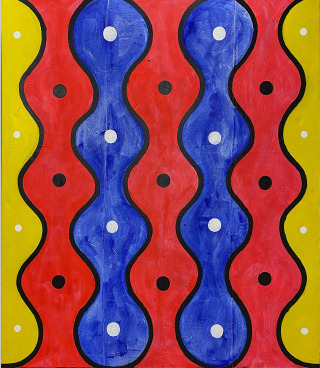Imagine a version of this review as a Socratic dialogue between two critics, one arguing for and one against Chris Martin’s often glitter-encrusted paintings now on view at Timothy Taylor gallery. Rational arguments could be made against the six paintings here, arriving at negative conclusions to fundamental questions: Are the paintings good? Do they succeed? Each time I've seen a show by this quintessential New York painter, who splits his time between the Catskills and Brooklyn, I've staged this debate in my mind. But the killjoy critic has never won yet.
There's the massive scale; the collaged bits of print imagery (planets, stars, music ephemera, animals, mushrooms—why make what you can borrow with scissors and glue?); the bold, often primary colors; indelicate brushwork galore; and the simple, if irregular patterns and geometries. Beyond glitter, the surfaces are sometimes embedded with sequins, as in Staring Into The Sun 748 Russell Hill Road, 2024, where, among the immense, wobbly lateral stripes in Rastafarian red, green, and yellow, these metallic flecks can be seen in the shape of snowflakes, a maple leaf, and so on. In this and half of the other paintings here, a starburst dominates the center of the composition and radiates outward.
Martin's bedazzled AbEx stylings, will have a good time with or without you. They are cousins to Katherine Bernhardt’s ebullient, slapdash Pink Panther paintings in this way. A room full of Martin’s canvases has never failed to lift my mood. However, the debate between the warring critics in my mind is real. The skeptic in me is won over by Speed of Light, 2024, which may be the best Martin painting I've ever seen, with its supernova of iridescent glitter exploding across the canvas's approximately 10 by 20-foot black expanse. In the backroom, Burst, 2024-25, achieves a similar effect on a smaller scale, while incorporating what look like cut-up bits of a sequined dress. But even the fan in me sees the shortcomings on display in Dark Matter, 2024.
Upon entering the gallery, this painting’s posterior—its more interesting side—greets you. On the back you see collaged bits of more solar systems alongside a Best of Donna Summer track list, a photo of a buffalo on an icy prairie, an obituary of the painter Al Held, and—most interestingly—photographs of more successful, earlier iterations of this very painting. On the front is a painting that’s been reworked and revised nearly to death, leaving a black field, some traces of muddied glitter, and polka dot “stars” mostly evenly distributed across its surface, except near the top, where maybe it was hard to reach?
This is the first time I’ve seen a show by the artist where one painting stood out clearly as a flop. And yet—perhaps heightened in contrast—the rest of the paintings here are great. The killjoy, once again, admits defeat.

